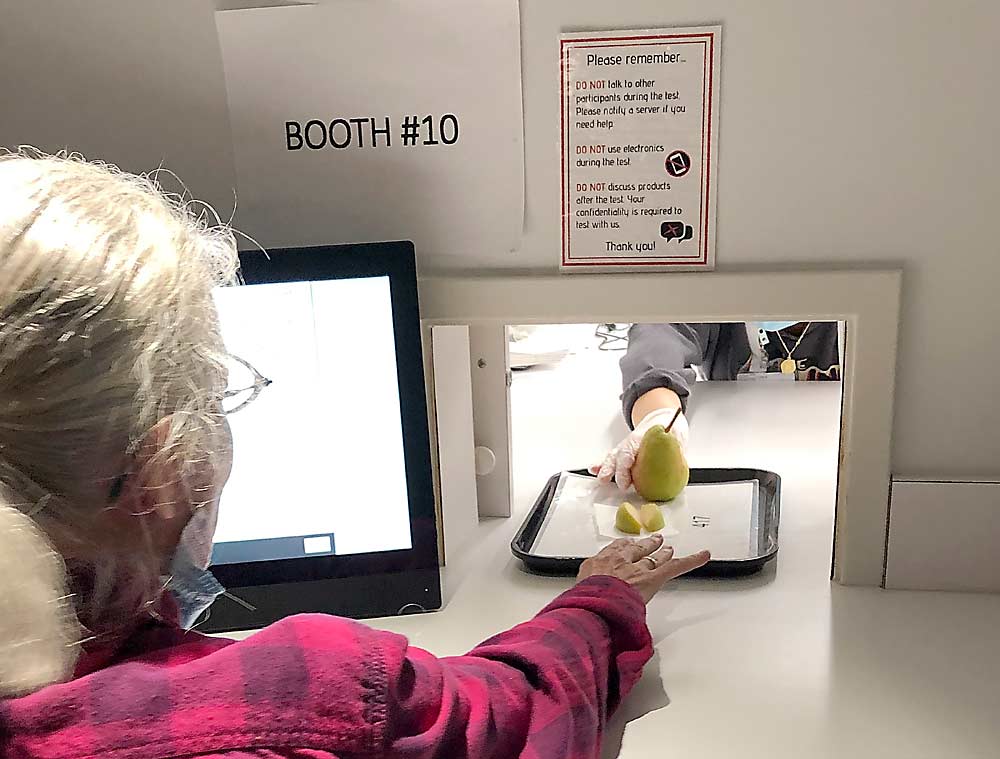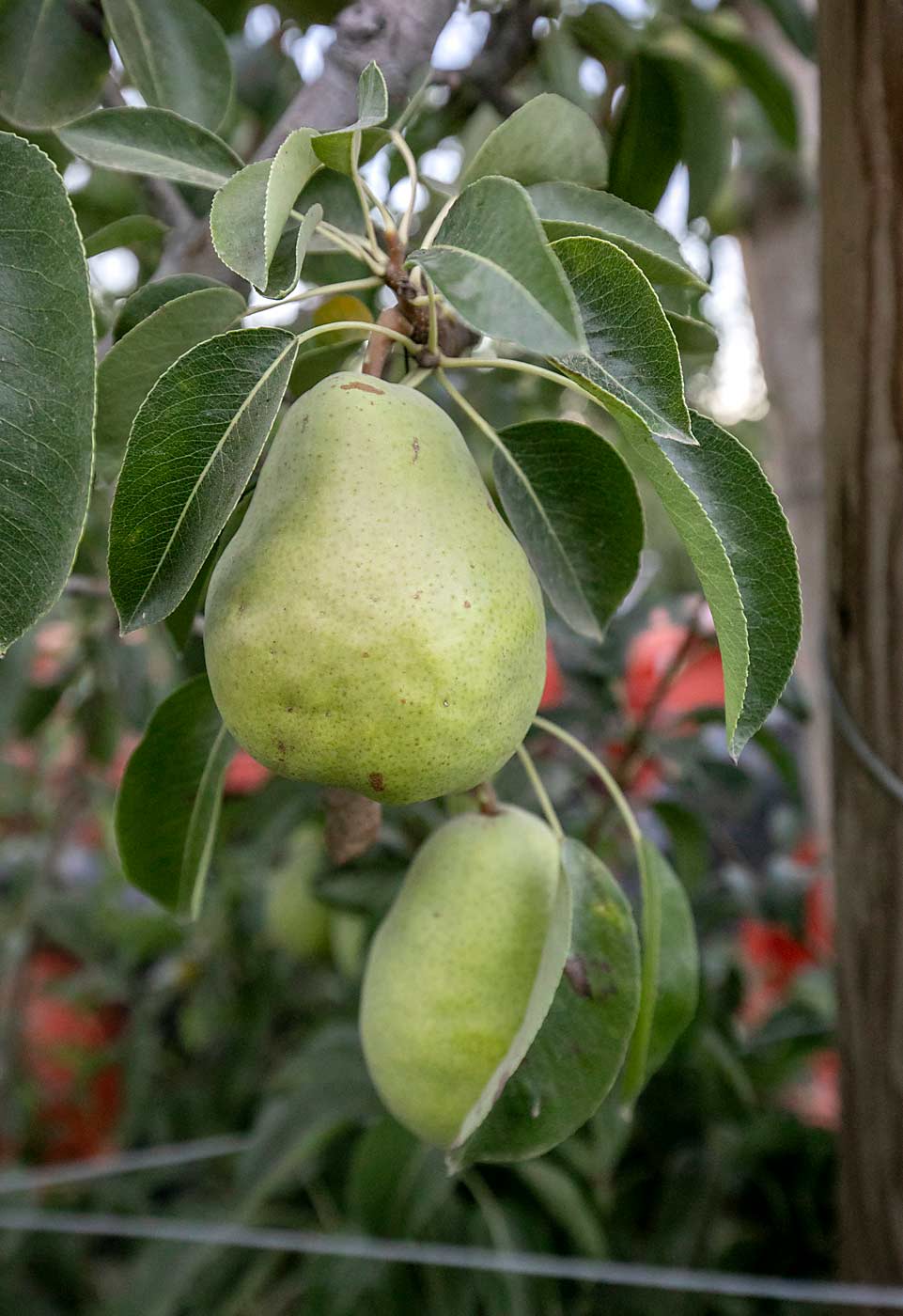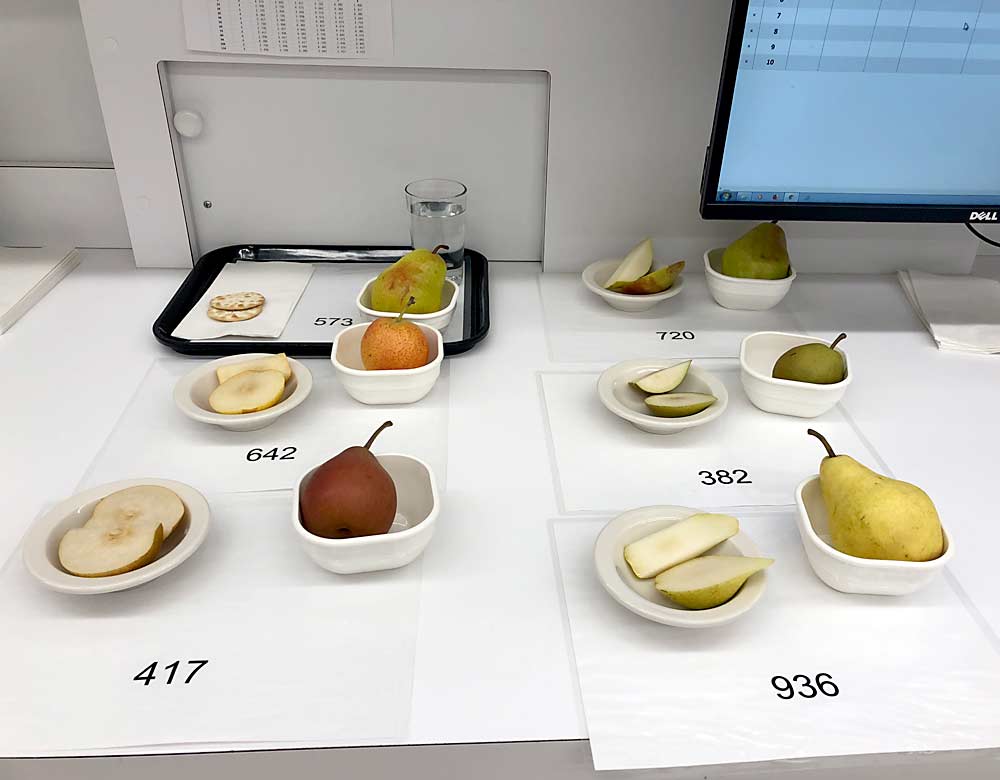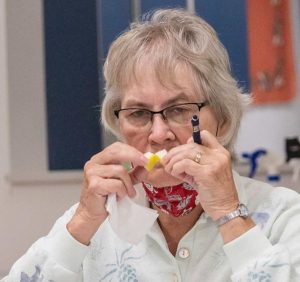
The great pear contest of 2021 ended with a crowded winners’ circle.
Self-identified Portland pear fans selected seven varieties — Paragon, Bartlett, Green Anjou, Concorde, Comice, HW 624 (which is marketed under the brand name Happi Pear) and Seckel — as the most overall liked in a 2021 consumer preference study by Oregon State University.
The research project examined attributes ranging from taste to texture and juiciness to woodiness, but the “overall liking” score measured the participants’ gut reaction after biting into a slice of fruit, said Ann Colonna, sensory program director at OSU’s Food Innovation Center in Portland and one of the principal investigators. Her partner was Carolyn Ross, a food science professor at Washington State University.
It’s one of the most important questions in the study.
“Taking everything into consideration …. this is the pear you like the most,” Colonna said.
Funded by the Fresh Pear and Processed Pear committees, which promote Northwest pears under federal marketing orders, the goal was to identify pear characteristics favored by Pacific Northwest consumers for both summer and winter pears.
Pulling from a database of 40,000 consumers, Colonna picked 219 pear fans to taste two slices of 23 varieties — each kept secret from the tester — in October and December 2021 at the OSU sensory laboratory. They rated those pears on scales of 1–9 for a slew of characteristics. They also judged appearance, based on seeing full, unsliced pears. All seven winners received overall mean scores with no statistical differences.
The information does more than crown kings, though, said Kevin Moffitt, president and CEO of Pear Bureau Northwest and manager of the Fresh Pear Committee. It will inform both researchers breeding new pear varieties and growers looking for existing varieties to plant in the United States.
“This is just the first step,” Moffitt said.
The study intentionally cast a wide net, said Bob Gix, a longtime member of the pear bureau’s science committee and a retired horticulturist for Blue Star Growers in Washington’s Wenatchee Valley. It featured varieties representing summer and winter, crunchy and soft, East and West coasts.
The findings reiterate one lesson the industry already knew: Deliver a pear that will ripen to consistent quality in a short time.
“I don’t think that’s particularly a new message,” he said.

Bartlett scored well, but that variety fills the market for only five or six months, Gix said. After March, other varieties must pick up shelf space. This project will help breeders, marketers and growers know what to focus on, including a visual indicator of when it is ripe, such as with Bartlett going from green to yellow.
“This gave us a road map of information,” he said.
Setting aside statistical differences, the obscure variety Paragon topped the “overall liking” list. Meanwhile, Bartlett, the most popular pear on American store shelves, came in a close second.
Paragon is a variety from the OSU Southern Oregon Research and Extension Center near Medford, where researchers first bred the Comice-Red Bartlett cross in the mid-20th century. Never patented, it’s rarely grown commercially, proving it takes more than great taste for a new variety to take off.
OSU entomologist and Paragon booster Rick Hilton was not shocked. Like the Bartlett, the Paragon is juicy, sweet and buttery with a skin that’s easy on the palate, checking all the boxes pear buyers usually say they love, he said. Though not involved with the breeding, over the years he and other Paragon supporters have written articles and pitched the pear at trade shows and symposiums — to no avail.
The research station has 29 Paragon trees today, while the largest commercial plot in Oregon is a couple of rows at a Medford orchard owned and operated by the Church of Jesus Christ of Latter-day Saints. The pear is a big hit at farmers markets and tops the list at nearly every test, he said.
“We did pear tastings with Master Gardeners,” he said. “It pretty much always came in as No. 1, hands down.”
Survey data
The experiment also yielded valuable socioeconomic data.
In a questionnaire, the 219 tasters told Colonna’s team they trust farmers, universities and science journals most when choosing who to listen to about food choices, more than their primary doctors. Lowest on the trust list were social media, food manufacturing companies, media and food retailers.

To select the tasters, Colonna conducted 1,940 surveys in which consumers said:
—They want to be able to tell when fruit is ripe.
—They put flavor at the top of their list of priorities, followed by juiciness, freshness, sweetness, firmness and ripeness. “Maybe we can label what the qualities are, in the store,” Colonna said.
—Their ideal pear is one that ripens from green to yellow; has a juicy texture that’s good for eating fresh and is ripe after a few days at home; and has a sweet, aromatic flavor.
—They like in-store samples as a way to learn about their produce.
With the help of WSU agricultural economist Karina Gallardo, Colonnaalso asked the respondents how much they would be willing to pay for the varieties. The results lined up with the scores for overall flavor but diverted from their overall appearance choices. In fact, Paragon scored quite low on appearance. Bartlett, Happi Pear and Seckel earned the highest “would pay” scores on the summer variety list. Paragon, Concorde and Green Anjou led the winter varieties.
Colonna’s research followed months of work by Ross, who trained panelists at WSU to recognize, in unnamed pear varieties, certain flavor and texture traits such as vanilla, grainy and bitter. Ross and her postdoctoral researcher, Maria Montero, used the panelist data to select pears for the Portland taste tests.
They aimed for diversity, trying to hit a variety of points on a grid of attributes, such as sweetness, juiciness and woodiness. They included Gem as a crunchy pear, just to represent that profile in the winter category. The Gem can be eaten crisp, fresh off the tree or ripened further to a soft texture. All except the Paragon were conditioned by Stemilt Growers of Wenatchee.
It did not surprise Colonna that many of the pear industry’s veteran varieties, such as Bartlett and Green Anjou, scored well. The key is conditioning, she said. Stemilt took pains to condition the study pears to their optimum quality, something consumers don’t always know how to do at home, despite the industry’s “Check the Neck” campaign.
“Our existing pears are of excellent quality,” Colonna said. “When pears are given to consumers at their optimum, people love them.”
Editor’s Note: A previous version of this story included a chart of pear evaluation data that was not intended for public release. Good Fruit Grower regrets the error.
—by Ross Courtney







Leave A Comment